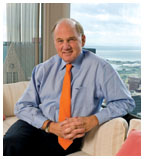
|
November 7, 2007: A moment with...
(Photo by Grant Hessler s’90) |
Robert Murley ’72
As a high school senior, Robert Murley ’72 applied to two colleges: Princeton, which he knew by reputation only, and the University of Southern California, his late father’s alma mater. When he was accepted at Princeton, Murley worried that he would not be able to afford to go. But thanks to a loan, a scholarship, and a job, Murley made the trip east from California, earned a degree in politics, and launched a successful career in investment banking. This year Murley, a vice chairman at Credit Suisse First Boston, has joined Nancy Peretsman ’76 to lead Princeton’s $1.75 billion fundraising campaign, which kicks off Nov. 9. He spoke with PAW’s Brett Tomlinson.
What were your first impressions of Princeton?
I came to the University without ever seeing the school. I just boarded the plane one fall morning in 1968. My mom dropped me off at the airport. She told me she loved me, and I remember her parting words: “Remember who you are and whose you are.” ... On the bus [from the Newark airport to campus], I was sitting next to an elderly woman, and I was very nervous. She said, “Well, where are you going?” I told her that I was going to be a freshman at Princeton, and she said I would love it, that it’s just beautiful. It didn’t seem so beautiful when I was on the New Jersey Turnpike or even when I first got on Route 1, but all of a sudden we approached the University and you could see these spiraling gothic towers off in the distance. She gave me an elbow in the side and said, “That’s Princeton.” It was breathtaking.
As a trustee, and now a fundraising chairman, you have fielded questions from many alumni. What do they want to know about what is happening at Princeton?
They like to talk about the strengths of the University in terms of its faculty [and] the quality of the student body. They’re interested in the admissions process — for example, how the decision to eliminate early decision was reached. They like to know as much as they can about the financial strength of the University, the endowment, and the stewardship of our assets. They like to know about the priorities of the board. ... People ask questions because they care about the place. Alumni are keenly interested in the strength, the well-being, the health, and the vibrancy of the University.
The University has set a target of $1.75 billion for the upcoming campaign. How did you arrive at that number?
I wouldn’t want anyone to think that we’re pulling it out of thin air, because that’s not true. It all starts with, what are the needs? What are the areas that need to be strengthened in order for Princeton to continue its excellence? In our case, we started looking at the areas of neuroscience, engineering, the creative and performing arts, financial aid, campus-life initiatives, the residential colleges — and you quickly come to a conclusion that you have a table of needs that is probably larger than what you can accomplish. Then you have to think carefully about alumni support for those needs. There is an intersection point between the needs and the capabilities of the donor base, and that intersection point for us happens to be $1.75 billion.
Compared to the goals of campaigns at Stanford ($4.3 billion), Columbia ($4 billion), and a few others, $1.75 billion might not seem remarkably ambitious. Is the University being modest?
No. Unlike Columbia, Penn, Harvard, Yale, or Stanford, Princeton does not have any professional schools. We have graduate programs, but [the campaign] is largely to support our undergraduate mission, as well as certain aspects of our graduate and research mission. While this might be a small campaign, relative to others, in absolute dollars, on a per-capita or per-student basis it is a very large campaign. It certainly is large and important for Princeton.
The University’s endowment reached $15.8 billion at the end of June. Why should alumni give to Princeton, when Princeton already has so much?
The first thing that I would say is that I never try to encourage people
to give only to Princeton. There are many other causes that are very worthy.
... I would also say that quality is expensive. It takes vast resources
to keep a place like Princeton on the top of the leaderboard, with cutting-edge
initiatives. We have been vigilant about using our endowment and getting
the proper balance between current and future generations. About 40 percent
of the operating budget for Princeton comes from the endowment. That is
significantly higher than our peer institutions. ... [But] a lot of the
endowment is already earmarked for very specific purposes, so if you want
to have new initiatives, you have to create new sources of capital to
support them.![]()

